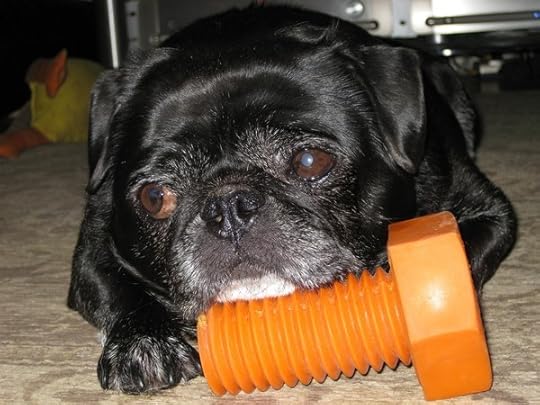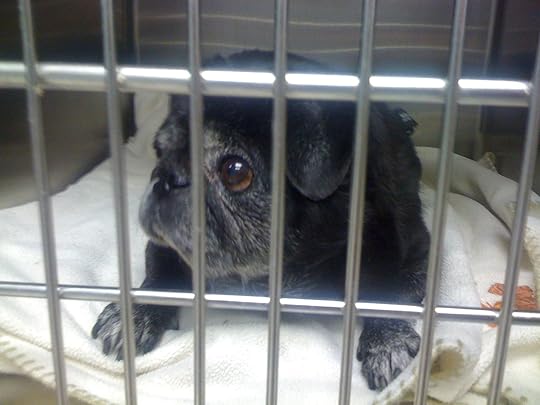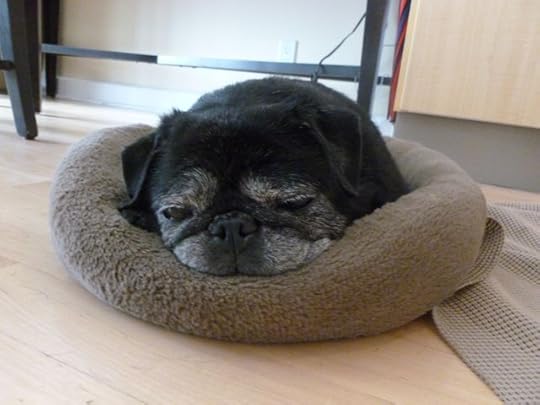August 1, 2011: Maximus…
I noticed the change in Maximus several weeks ago. Normally possessed of an appetite characteristic of most pugs, he would scoff down treats on sight, snapping up kibble, liver brownies, and fingertips with equal relish. And then suddenly, three weeks ago, something changed. While he didn't exactly turn down the treats, he no longer attacked them with the same gusto. Rather than wolf them down as fast as he could, he seemed deliberate, almost cautious in his approach – carefully sniffing and disposing of them with a slow, extended chew. It was enough to tip me off that something was wrong. Over the course of the next couple of days, I observed him more closely and noticed other changes in his behavior. Always the first one to finish his meals, wolfing down his breakfasts and dinners as if they'd be the last ones he ever eat, Max suddenly seemed less enthusiastic about what was set down in front of him. He always seemed considerably slower on his daily walks, lagging behind even Jelly with her hip dysplasia. Max had always been the most laid-back of the foursome, preferring to spend the better part of the day in his doughnut bed or lying about in the sun, but even his typical laziness seemed fervent compared to the lethargy he was exhibiting.
I made an appointment and took him in last week. During the check-up the vet appeared to discover the problem: a broken tooth that had led to an abscess. No wonder he couldn't eat and had been so unlike himself. He was in, no doubt, a great deal of pain. The vet sent us home with antibiotics, pain meds, and a scheduled dental surgery the following Monday.
I hate bringing my dogs in for surgery, particularly Jelly and Maximus who cower and tremble, gazing out at you longingly as if to say "Please, don't leave me!" and "What'd I do?!", but if dental surgery was going to get Maximus back to his old self then it had to be done.
I dropped him off Monday morning, then headed off to set where I awaited word. Finally, some time after lunch, the doctor called to inform me the surgery had been a success and that Maximus was doing fine. They'd had to remove two teeth in addition to two masses inside his mouth. The latter had been sent out for testing. To be honest, I wasn't that concerned. Throughout his life, Maximus had been prone to these mystery masses that seemed to sprout out everywhere -on his belly, on his back, between the pads of his paws – but test after had shown every one of them to be benign. So really, I thought, why should this time be any difference.
Maximus returned home and, in the hours after his surgery, almost seemed to be his old self. His appetite seemed to pick up as did the pace of his walk. I'd completely forgotten about the outstanding test results until I received a message from the animal clinic asking me to call them back. I did. The technician informed me the doctor wanted to go over Maximus's test results with me. I asked if everything was alright, a question that, curiously, seemed to catch her off guard. She stumbled a little, then suggested the doctor would be able to answer my questions. "Should I bring Maximus?"I asked her. "No,"she informed me, "the doctor just wants to talk to you."
And so, I went to the animal clinic where we discussed the test results. Afterwards, I had the doctor forward me the histopathology report. "You were hoping for something benign and I am going to give you some really bad news,"it read. "This is malignant melanoma." Then, after a detailed explanation of the type of tumor we were dealing with: "These tumors are dangerous both because of locally invasive and recurrent growth, and because of a very high metastatic risk to lymph node and then lung."
I've made an appointment to have Maximus seen by a specialist, a canine oncologist at Guelph University. There, they'll run a battery of tests to get a better sense of what we're dealing with after which they'll be able to suggest some treatment options. Provided the cancer hasn't already spread to his lungs in which case, the doctor informs me, the prognosis is not good.
Rather than wait around, I set aside less pressing concerns to surf the web in search of alternative/homeopathic treatments and came up with a list of safe, natural remedies that anecdotal evident suggests can help (and, at the very least, can't hurt). We'll see how he responds.
I'm still a little stunned. This same time last year, I thought Jelly was on her last legs. Suffering from hip dysplasia, arthritic joints, and a spinal condition, she was barely able to walk, much less squat to pee. I thought I was out of options – until I came across an article on the surprising results of stem cell treatments for dogs and horses. I looked into it and, with the help of the fine folk at Vet-Stem, proceeded with the treatment given the understanding that results vary. Well, one year later and not only is she squatting and walking, she's actually charging down the corridor in albeit wobbly form.
Here's hoping for a second miracle.
Tagged: pugs








Joseph Mallozzi's Blog
- Joseph Mallozzi's profile
- 39 followers






